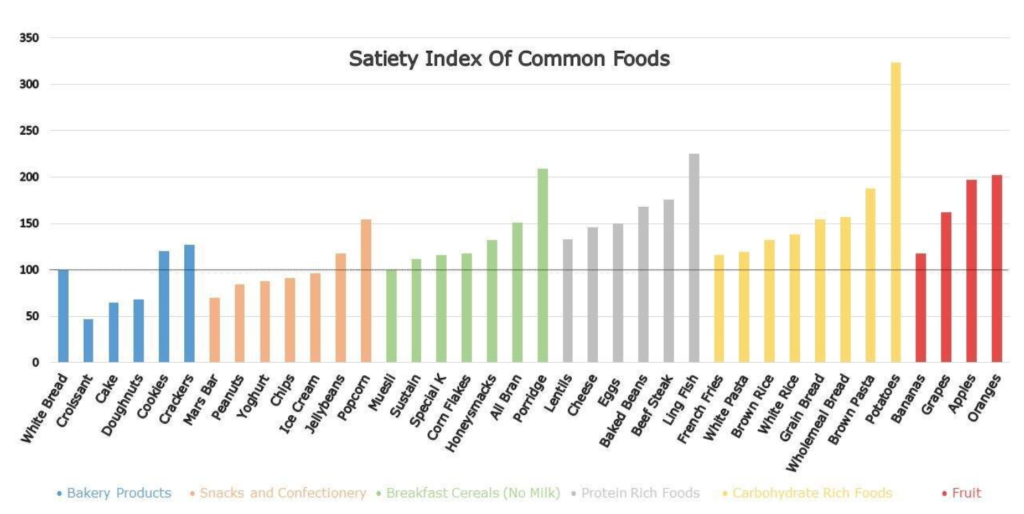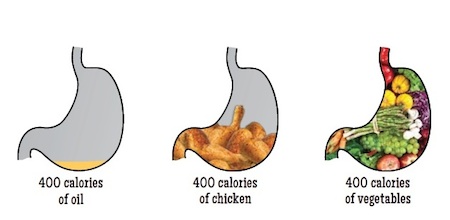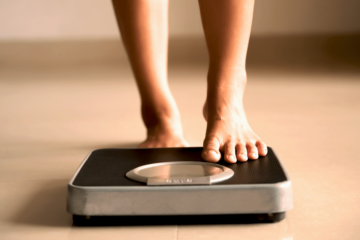‘Satiety’ means being satisfied with our food, so we don’t keep on wanting to eat more. So we can stop thinking of how to get our hands on more food. Clearly satiety and weight loss go together.
With the increase of ‘grazing’ throughout the day in our world, it is clear that satiety is becoming less common. People just want to keep on eating all day long.
In this post, I want to look at what causes a sense of satiety, how we can use our knowledge of satiety for weight loss and common satiety-stealers.
What exactly is satiety?
Satiety is all about feeling full and staying full – so we can get our minds off food, we can focus on things other than eating or drinking caloric drinks, and we can get the macronutrients we need to be healthy.
Satiety is how satisfied we are in between meals.
Satiation is what signals us to stop eating a meal.
If we do not experience these signals to stop eating or to feel satisfied between meals, we eat more – resulting eventually in weight gain.
Which hormones promote satiety?
Three hormones are tied up with the sensation of satiety:
- Ghrelin – the hunger hormone, made in the stomach. The more of it we have in our blood stream, the more hungry we feel. We need to eat in such a way that ghrelin is suppressed – so we feel less hungry.
- Leptin – the satiety hormone, made in our fat cells. The more leptin we have in our blood, the fuller we feel and the less hungry. We want MORE leptin so we don’t feel the need to eat all the time.
- CCK – tells us we are full after a meal as nutrients leave the stomach for the small intestine. It is made in the small intestine and delays emptying of the stomach – leaving us feeling full longer.
In other words, these hormones control our hunger signals.
We can also call these the ‘weight loss hormones’ because any shift in their delicate balance drastically affects our body’s ability to regulate energy demands and storage, leading to weight problems. There is a strong link between satiety and weight loss.
Things that can interfere with hunger signals (satiety hormones)
The following things can cause the balance between these hunger hormones to become dysfunctional. This can cause us to feel hungry all the time.
- Eating the wrong types of food
- Insufficient sleep
- Obesity
- Excessively flavoured foods
- Excessive food variety
We will look at each one of these now in more detail.
Foods that enhance satiety
Protein induces satiety in the short term. Low-fat dairy products, eggs, and legumes enhance satiety. Although energy-dense (high in calories), nuts have some satiety-inducing effects. Satiety induced by dietary fibre sources, such as oats and rye, are well documented to increase satiety but do not always lead to eating fewer calories and the resultant weight loss.
This chart shows which foods in each group tend to lead to greater satiety.

The hormones governing satiety are influenced by the stretch receptors in the stomach. This next image shows how certain foods of the SAME calorie value, stretch the stomach, which in turn results in more leptin and less ghrelin when the stomach indicates its fullness to the brain.
Tips for using food to increase satiety are to consider
- getting around 20g. protein in each meal, OR
- filling up on lower calorie high fibre foods, such as vegetables, legumes and fruit, instead of a lot of grain foods.
Either approach can make a difference. Try one, the other or both to see what works best for you.
Sleep and satiety
Short sleep duration is associated with reduced leptin, elevated ghrelin and increased body mass index (weight). A 2004 study with 1024 participants found participants with short sleep, under 7 hours per night, had reduced leptin and elevated ghrelin. This was associated with increased appetite and higher BMI.
If you find yourself feeling tired at 11AM, and hungry all afternoon, this can be changed by having a regular bedtime and a solid 7 – 9 hour sleep each night. It is well worth getting earplugs, a ‘white noise’ maker, an eye mask, better blinds and a sufficiently cool room if your sleep quality is poor and you are having difficulty losing weight. You will continually struggle with hunger if your sleep is poor, which then results in eating too much.
How obesity interferes with satiety
Leptin levels are higher in individuals who are overweight or obese compared to individuals who are normal weight. The higher levels of resistance to leptin appear to contribute to dysregulation of hunger/satiety signalling and thus affect eating behaviour.
Leptin tells our brains that we have enough fat stored and don’t need to eat. It is produced by our fat cells. When you are overweight, those extra fat cells pump out too much leptin. Instead of this resulting in your brain knowing you are full and signalling to stop eating, which is how this system should normally work, the excessive leptin results in the feedback loop breaking down – the brain no longer ‘sees’ the leptin. Your brain erroneously thinks you are starving and signals you to eat more and to stop moving around in order to maintain fat.
In other words, you end up eating more and exercising less. And you get fatter. But it is not, firstly, the result of you eating more and exercising less – but rather the result of a broken hormonal system driving these behaviours.
If this is you – what to do:
What can you do to get these hormones working properly again if you are already obese?
Not every overweight or obese person finds themselves in this position. Different chemical pathways are affected by obesity at different rates in different people. If you are noticing these patterns, however, here is what you can do to lose weight:
- Don’t depend upon satiety signals to guide you.
- Use a calorie food tracker, like My Fitness Pal or Lifesum, and pay attention to portions, high fibre foods and up to 20g. protein per meal.
- Arrange some long term weight loss support, such as a Facebook group led by an accredited nutritionist/dietician (ie. join a programme with group support), or see a nutritionist for individual support on the journey. Expect to see them at least monthly for a year or more.
Food flavour and hunger hormones
The more flavoursome our food, the less balanced our satiety hormones and the less satiation. Therefore, more flavour leads to increased appetite, more calories eaten and more chance for weight gain. It is hard to disassociate palatability with satiety.
This is why eating ‘plain foods’ most of the time tends to result in better weight control. In our society, we have come to expect highly flavoursome foods as a matter of course. These foods are usually quite high in sugar, salt or fat. This results in eating more food, faster, both recipes for weight gain because they override the ability of the hunger hormones to work properly in the time given.
Try these everyday meal suggestions, and keep highly flavoured foods for special occasions.
- Choose porridge or wholemeal bread over processed cereals or white sourdough bread.
- Consider a French-style salad and lentils or lean meat with vinaigrette dressing instead a salad full of candied nuts, dried fruit and a creamy dressing.
- Base dinner on a lot of vegetables and whole-food starches (brown rice, potatoes) rather than a meal based around low fibre white pasta or white rice with highly flavoured or fried (fatty) meats and sauces.
- Choose fruit over cake or pastries for snacks, and plain coffee over mocha and coffees with syrups.
Food variety and hunger hormones
A number of studies have shown that the greater the choice of foods offered at a single eating occasion, the more people will eat.
For example, at a degustation meal, with 8 or 9 different small meal portions served, most people will eat a lot more than if they ate the same combined weight of a meal as a single meal on one plate – as a normal meal. The large variety of foods, as in a degustation meal, leads to eating a lot more food.
It is the same thing when eating with friends at a restaurant with a lot of shared plates or platters. The sheer variety of foods available means you will eat a lot more. It is hard to resist doing so, and hunger hormones do not help you. If weight loss is a goal, it is always better to order your own meal and eat it only.
We also experience this when we sense we are ‘full’ with a meal, then find we can apparently fit in dessert when we see the dessert menu. The satiety signals reduce with the introduction of a new type of food.
It is worth mentioning here that the idea that a person can eat any amount of truly healthy foods and maintain weight – only works if that person expends the same amount of energy that they are taking in. For the average semi-sedentary person, it does not work. Eating even healthy foods in great variety and flavour usually results in eating too much, by interfering with hunger signals as with other foods.
Tips to ‘read’ your hunger signals
In a world where we are led by our five senses, this can at first glance appear quite hard. And our society makes it even harder by the sheer variety and tastiness of foods always available to us. These weaken our capacity to ‘listen to’ hunger signals by manipulating the hunger hormone balance. It seems easier to follow diet plans, calorie counting and strictly measured portions.
While all of these methods can be beneficial as guidelines, our natural hunger mechanism is what humans (and animals) have successfully relied upon, to know how much to eat, for millennia. By carefully minimising the things that interfere with those hunger signals, we can get back in touch with this reliable mechanism. We can link satiety and weight loss together again.
1) Eat only when hungry
From infancy, we are trained to eat at set times in the day, to clean the plate and to eat whenever friends come over. Only eating when hungry is not that common. So it’s something many of us have to learn.
What is “hungry”? Simply put, it’s when you feel kind of empty. But we have to differentiate this from the feeling of low blood sugar – and shakiness or mental fog that can come with that. Read my blog post on overcoming hypoglycaemia if this is a problem for you.
Today, many people don’t know that feeling that their stomach is ’empty’. So many of us suffer from some degree of hypoglycemia that we never let ourselves get anywhere near the “being hungry” point. Advice to those with hypoglycaemia is to keep on eating, all day long, which always ends up meaning ‘more calories’ – and more weight. Dr Joel Fuhrman says in Eat to Live that ‘Hunger is an experience that many people fear.’
We have to get comfortable with feeling a bit hungry – in fact, quite hungry – before we begin eating a meal. This is something to practice and become used to.
Work towards longer gaps between meals in which you drink only water. When you first think you are hungry, it is usually only that the prior meal has left the stomach and been mostly absorbed. That’s all – it’s not ‘hunger’, it’s not time to eat again. Have a big glass of water and wait longer! You may begin with one hour, then go to two hours, then more up to four hours or more between meals. Even once a day is a good practice and you will soon start achieving the results you desire – linking satiety and weight loss.
2) Stop eating before you are too full
As well as getting back in touch with feeling hungry before eating, we also need to learn how much food we each need to eat in order to never feel overly full, but have enough food to get us to the next mealtime. It’s about fine-tuning. It may seem tricky as an adult, but children do it perfectly all the time – till we ruin it for them by giving them tempting sweets and snacks when they are not hungry yet, or insisting they finish all their meal.
Ask yourself during a meal if you have had enough. Will that hot drink after dinner leave you feeling ‘too full’? Try and avoid ever feeling that way – and learn to appreciate always feeling satisfied and light, not groggy and over-full.
3) Limit snacking and ‘grazing’
If you snack between meals, you will soon find that you are actually full after just a few mouthfuls of a normal-sized meal. If you stop eating then, in order to not get ‘over full’, you will end up not being able to get to the following meal without snacking. You have set up a vicious circle that is difficult to break.
There is no virtue in having a small meal when you have eaten high-calorie snacks between meals. You are only tricking yourself onto a weight gain merry-go-round.
The way to break this habit is to get busy and miss one between-meal snack. Or make it tiny (such as one piece of fruit). Your aim is to get to the next meal time good and hungry.
This way of thinking is not about depriving yourself. It is about learning how to enjoy food more than you ever did before.
Summing Up
Be patient. All this takes self-discipline and mindfulness for the satiety mechanism inside of you, dulled from years of being tampered with, to become sharp and dependable again.
Each time you do it, it will get easier. You’re developing ‘muscle memory’ in your mind.
Try some of these challenges for a few weeks. It is always a good feeling to get back in tune with the body’s natural mechanisms, working with the natural design.
Satiety and weight loss can then begin to come together.





0 Comments